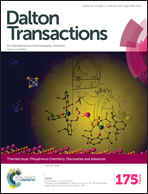Reactions of [Cu(X)(BPEP-Ph)] (X = PF6, SbF6) with silyl compounds. Cooperative bond activation involving non-coordinating anions†
Abstract
Bond activation of silyl compounds, assisted by the cooperative action of non-coordinating anions, is achieved using Cu(I) complexes coordinated with a PNP-pincer type phosphaalkene ligand, [Cu(X)(BPEP-Ph)] (X = PF6 (1a), SbF6 (1b); BPEP-Ph = 2,6-bis[1-phenyl-2-(2,4,6-tri-tert-butylphenyl)-2-phosphaethenyl]pyridine). Complexes 1a and 1b react with Me3SiCN to form Me3SiF and Cu(I) cyanide complexes of the formula [Cu(CN-EF5)(BPEP-Ph)] (E = P (2a), Sb (2b)), in which the CN ligand is associated with the EF5 group arising from EF6−. Formation of the intermediary isonitrile complex [Cu(CNSiMe3)(BPEP-Ph)]+SbF6− (3b) is confirmed by its isolation. Thus, a two-step reaction process involving coordination of Me3SiCN, followed by nucleophilic attack of SbF6− on the silicon atom of 3b is established for the conversion of 1b to 2b. Complex 1b cleaves the H–Si bond of PhMe2SiH as well. The isolation and structural identification of [Cu(BPEP-Ph)]+BArF4− (1c) (BArF4 = B{3,5-(CF3)2C6H3}4) as a rare example of a T-shaped, three-coordinated Cu(I) complex is reported.
![Graphical abstract: Reactions of [Cu(X)(BPEP-Ph)] (X = PF6, SbF6) with silyl compounds. Cooperative bond activation involving non-coordinating anions](/en/Image/Get?imageInfo.ImageType=GA&imageInfo.ImageIdentifier.ManuscriptID=C5DT03166D&imageInfo.ImageIdentifier.Year=2016)
- This article is part of the themed collection: Phosphorus Chemistry: Discoveries and Advances

 Please wait while we load your content...
Please wait while we load your content...